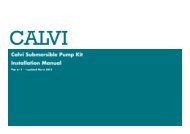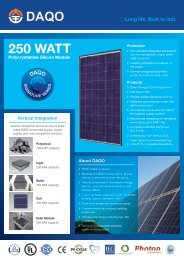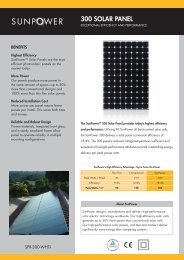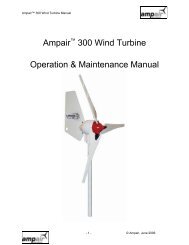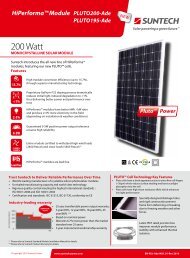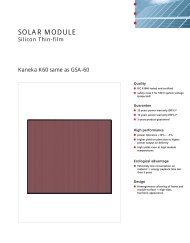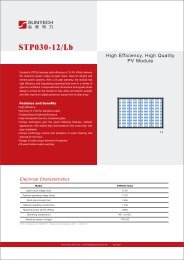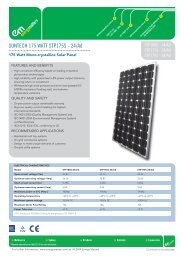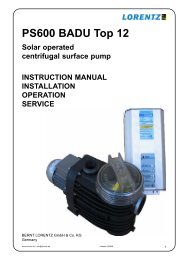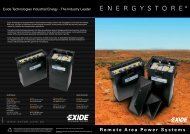Installation Manual - Energy Matters
Installation Manual - Energy Matters
Installation Manual - Energy Matters
Create successful ePaper yourself
Turn your PDF publications into a flip-book with our unique Google optimized e-Paper software.
<strong>Installation</strong> <strong>Manual</strong><br />
Conergy TS<br />
Open and Closed Systems<br />
www.conergy.com.au
Table of Contents<br />
Table of Contents<br />
1<br />
1.1<br />
Installer Information<br />
The environmental benefits<br />
2<br />
2<br />
ENGLISH<br />
1.2<br />
Why Conergy?<br />
2<br />
1.3<br />
How does the system work?<br />
2<br />
1.4<br />
Conergy TS model number explained<br />
4<br />
1.5<br />
Important safety information<br />
5<br />
1.6<br />
If the customer is away for a period of time<br />
5<br />
1.7<br />
Water discharge through the pressure valve<br />
5<br />
2<br />
Troubleshooting<br />
6<br />
2.1<br />
Low solar energy input<br />
6<br />
2.2<br />
Solar collector shading<br />
6<br />
2.3<br />
Booster system not operating<br />
6<br />
2.4<br />
Excessive water discharge from the valves?<br />
6<br />
2.5<br />
Using more hot water than anticipated?<br />
6<br />
3<br />
System Maintenance<br />
7<br />
4<br />
<strong>Installation</strong> Instructions<br />
8<br />
4.1<br />
Typical open circuit assembly diagram<br />
8<br />
4.2<br />
Typical system assembly<br />
8<br />
4.3<br />
Connection and mounting part kits<br />
9<br />
4.4<br />
Roof location selection<br />
9<br />
4.5<br />
Supplementary heat sources<br />
10<br />
4.6<br />
Common installation procedure<br />
10<br />
4.7<br />
System installation<br />
11<br />
4.8<br />
System diagrams and components<br />
12<br />
4.9<br />
Plumbing connections - Open Circuit models<br />
21<br />
4.10<br />
Plumbing connections – Closed Circuit models<br />
22<br />
4.11<br />
Draining the storage tank<br />
23<br />
4.12<br />
Filling the Closed Circuit jacket<br />
23<br />
4.13<br />
Electrical installation instructions<br />
25<br />
4.14<br />
Gas (AES) installation instructions<br />
26<br />
5<br />
Commissioning & Customer Hand Over<br />
27<br />
6<br />
ANNEX - Mounting frame for flat roof<br />
28<br />
Conergy TS <strong>Installation</strong> <strong>Manual</strong>
1 <strong>Installation</strong> Information<br />
1 <strong>Installation</strong> Information<br />
ENGLISH<br />
You are installing one of the most advanced solar water heaters in the world. This manual provides<br />
you with the essential information needed to install the Conergy Thermosiphon System correctly.<br />
Please read it carefully and follow all the instructions. We hope you find the following information<br />
useful.<br />
1.1<br />
The environmental benefits<br />
A Conergy solar water heater is an excellent and economic energy solution. By using the sun’s heat<br />
to heat our water, we cut down on the amount of fossil fuels needed to be burnt to supply electricity<br />
to do the same.<br />
1.2<br />
Why Conergy?<br />
Conergy offers Australia’s largest range of renewable energy products and our company operates<br />
in 25 countries on 5 continents. Our products are used in 100 000’s of Solar Home Systems for Hot<br />
Water and Solar Electricity worldwide and we offer the leading products in this technology.<br />
Before you can sell in Australia, or achieve any of the State or Federal Government rebates, your<br />
product must comply with the rigorous Australian Standards for solar water heaters. Our products<br />
comply with all these standards. The Federal Government Renewable <strong>Energy</strong> Certificate program,<br />
called RECs, is an indication of solar efficiency. If you compare any of the Conergy products with<br />
an equal competitor model, you will find that Conergy systems often achieve more RECs than our<br />
competitors.<br />
1.3<br />
How does the system work?<br />
Under normal operating conditions the potable water within the potable storage tank is heated by<br />
the solar collectors. For example, in an open circuit system where the household hot water is in the<br />
collector circuit, cold water is pushed downwards via the long external pipe from the storage tank to<br />
the bottom of the solar collector. As the water is heated in the absorber by the sun, it rises to the top<br />
of the collector then travels through the short external pipe into the storage tank.<br />
The Conergy TS solar water heater is supplied in kit form so that the installer can assemble and<br />
connect the solar water heater in various configurations to suit the installation location and user<br />
requirements. Typically the kit contains the four main components of your solar water heater system<br />
which are the potable water storage tank, the solar collector(s), the Ancillary <strong>Energy</strong> Support (AES)<br />
System and the parts box, containing pipes fittings and mounting rails to interconnect and mount the<br />
system. Please note the AES system can be either electric or gas operated dependent on the model<br />
purchased.<br />
<br />
Conergy TS<br />
<strong>Installation</strong> <strong>Manual</strong>
1 <strong>Installation</strong> Information<br />
1.3.1<br />
Storage Tank & Solar Collectors<br />
ENGLISH<br />
Conergy TS 300 litre vitreous enamel tank<br />
LC collector<br />
The potable water storage tank is used to store the heated water ready for household use. It is<br />
constructed using high quality vitreous enamel lined low carbon steel to provide long life. The<br />
tank is insulated with a high density polyurethane material to ensure minimal heat losses and<br />
maximmum structural strength.<br />
The solar collectors contain a multi tube copper water way system bonded to a solar absorber<br />
plate, the combination of which collects solar energy and transfers it to the fluid within the collector<br />
circuit. The absorber plate system is enclosed in an insulated metal casing covered with a high<br />
strength toughened glass sheet that protects the absorber system from physical damage.<br />
1.3.2<br />
Ancillary <strong>Energy</strong> Support (AES) - Booster System<br />
Electricity and gas are the two options for the AES system. Please assist the customer in choosing<br />
the most suitable AES system type. An electric Ancillary <strong>Energy</strong> Support (AES) system uses an<br />
electric element to heat part of the stored household water on those occasions when there is<br />
reduced solar energy available e.g. cloudy days.<br />
The electricity supply to the electric element within the storage tank is automatically controlled<br />
by an internal thermostat which will only allow the electric element to operate if the storage tank<br />
water temperature falls below 60 °C and will, even then, only consume electricity until the water<br />
temperature is increased to 60 °C at which stage it turns off automatically.<br />
Conergy TS <strong>Installation</strong> <strong>Manual</strong>
1 <strong>Installation</strong> Information<br />
ENGLISH<br />
For gas AES systems the electric element in the storage tank is not connected to an electricity<br />
supply. Instead a continuous flow gas water heater is fitted adjacent to the storage tank and in<br />
series with the hot water supply from the storage tank and the household hot water pipe system.<br />
As the hot water from the solar storage tank passes through the gas heater its temperature is<br />
automatically monitored. If the temperature is below 60 °C the gas heater will add the heat required<br />
to deliver hot water of at least 60 °C. If the water temperature is above 60 °C the gas heater is<br />
programmed not to ignite.<br />
1.4 Conergy TS model number explained<br />
The model number of the system is divided into sections to describe the system which you have<br />
installed. For example: TS300/4/0/E24/V/E20SB.<br />
The first two digits are used to determine the system type eg. TS300/4/O/E24/V/E20SB. TS is a<br />
thermosiphon system.<br />
The next three digits are used to determine the tank storage volume eg. TS300/4/O/E24/V/E20SB.<br />
In the example 300 indicates that the storage volume is a nominal 300 litres. 180 would indicate a<br />
nominal storage volume of 180 litres.<br />
The fourth digit indicates the nominal collector surface area eg. TS300/4/O/E24/V/E20SB. In the<br />
example 4 indicates 4m 2 and 6 would indicate 6m 2 .<br />
The next figure indicates the tank model type eg. TS300/4/O/E24/V/E20SB. In the example O indicates<br />
an open circuit tank and a C would indicate a closed circuit tank.<br />
The next figures indicate the AES model type eg. TS300/4/O/E24/V/E20SB. In the example E24<br />
indicates an electric 2.4kW AES a G21 would indicate a 21 litre/min gas AES.<br />
The next figure indicates the tank construction eg. TS300/4/O/E24/V/E20SB. In the example V<br />
indicates a vitreous enamelled tank and an S would indicate a stainless steel tank.<br />
The final 5 figures indicate the Collector model eg. TS300/4/O/E24/V/E20SB. In the example the<br />
collectors are model E20SB. Other models are E20BC, E25BC or F20LC.<br />
<br />
Conergy TS<br />
<strong>Installation</strong> <strong>Manual</strong>
1 <strong>Installation</strong> Information<br />
1.5<br />
Important safety information<br />
|<br />
All water heaters have the ability to produce hot water very quickly. To reduce the risk of scald<br />
injury it is recommended that a temperature control valve be fitted to the hot water supply pipe<br />
work. This valve should be checked at regular intervals to ensure its operation and settings remain<br />
correct. Please check that the pressure & temperature relief valve relief pipe is not located where<br />
it can cause damage if hot water is discharged.<br />
ENGLISH<br />
|<br />
This water heater is not intended for use by young children or infirm persons without supervision.<br />
Young children should always be supervised to ensure that they do not play with hot water taps<br />
or the water heater.<br />
Hydrogen gas can accumulate!<br />
If the hot water system is not used for two weeks or more, a quantity of hydrogen gas, which is highly<br />
flammable, may accumulate in the water heater. To dissipate this gas safely, it is recommended that<br />
a hot tap be turned on for several minutes at a sink, basin or bath but not a dishwasher, clothes<br />
washer, or other appliance. During this procedure there must be no smoking, open flame or any other<br />
electrical appliance operating nearby. If hydrogen is discharged through the tap, it will probably make<br />
an unusual noise as with air escaping. Do not place hands or any part of your body beneath the tap<br />
during this procedure.<br />
1.6<br />
If the customer is away for a period of time<br />
If the system is not to be used for a period of a week or more during the summer months it is advisable<br />
to turn off the electricity supply to the booster and if practical, cover the solar collectors. If the solar<br />
collectors are not covered there is a possibility that the high temperature valve in the storage tank<br />
may open and disperse small amounts of hot water for a short period to reduce the storage tank<br />
temperature while you are away. This is a normal function and does not harm the system.<br />
1.7<br />
Water discharge through the pressure valve<br />
All Conergy solar water heaters have two pressure valves located within the system configuration.<br />
The cold water expansion valve, located in the cold water supply pipe, may release a small amount<br />
of water from time to time during the heating cycle of the system. The water discharge is water<br />
expanding due to the heating process. Normally the discharge will be less than 10 litres per day.<br />
The pressure & temperature valve, located on the storage tank, may also release a small expansion<br />
discharge.<br />
Conergy TS <strong>Installation</strong> <strong>Manual</strong>
2 Troubleshooting<br />
2 Troubleshooting<br />
ENGLISH<br />
What to check for during service calls<br />
If there is not enough hot water we recommend that the following points are considered as part of the<br />
service call. The most obvious reasons for a lack of hot water could be one of the following:<br />
2.1<br />
Low solar energy input<br />
If there have been prolonged periods of cloud or winter is approaching, it may be necessary to<br />
reconsider the permitted boosting time for time-clock controlled systems or to turn on the booster<br />
for systems with a booster isolation switch.<br />
2.2<br />
Solar collector shading<br />
Often trees or other buildings can shade the solar collectors or there can be a dirt build-up on the<br />
glass cover. Trees should be cut back if possible or the system relocated if removal of the shading<br />
is not possible in the present location. If the glass is dirty this should be cleaned with any normal<br />
domestic glass cleaner. If rainwater collection occurs from the same roof on which the solar water<br />
heater is located, do not use chemical cleaning agents to clean the collectors. Any spillage of these<br />
onto the roof could cause contamination of water in the rainwater tank.<br />
2.3<br />
Booster system not operating<br />
For electric systems the fuse or circuit breaker supplying the AES System should be checked. If the<br />
time clock (where fitted) and the fuse or circuit breaker are operational and the water is cold, you can<br />
turn the booster isolator on and off to see if the electricity meter speed changes. If there is no change<br />
in speed, it indicates there may be a booster problem, which would need to be investigated.<br />
For gas systems the gas and electric supplies to the gas heater should be checked to ensure they are<br />
both on. If water temperature from the gas heater is below 60 °C and both supplies are on and the<br />
gas heater does not ignite there may be a problem, which would need to be investigated further.<br />
2.4<br />
Excessive water discharge from the valves?<br />
If there is a discharge of more than 10 litres per day from any of the systems valves, it indicates there<br />
may be a problem with the valve or an increased water supply pressure.<br />
2.5<br />
Using more hot water than anticipated?<br />
Often the hot water usage of showers, washing machines and dishwashers is underestimated by<br />
the customer. Review these appliances to determine if the daily usage is greater than the storage<br />
volume of the water heater. Depending on the model, our TS system tanks contain 180 or 300 litres<br />
of hot water therefore if the customer’s usage is greater than 300 litres within a short period of time,<br />
there may be periods where the water temperature is slightly lower than normal. It is also advisable<br />
to inspect hot water tap washers etc. for leakage and replace if necessary.<br />
<br />
Conergy TS<br />
<strong>Installation</strong> <strong>Manual</strong>
3 System Maintenance<br />
3 System Maintenance<br />
The Conergy system is designed such that there is little to do regarding system maintenance. Should<br />
you decide that you want to inspect the roof mounted system it is essential that you use all safety<br />
devices required to ensure your personal safety.<br />
ENGLISH<br />
Glass cleaning usually occurs by natural rainfall, however if the installation is in an industrial (or<br />
similar) area with high levels of airborne particles then a qualified person can clean the collector<br />
glass with normal window cleaning chemicals and equipment. If rainwater collection occurs from the<br />
same roof on which the solar water heater is located, do not use chemical cleaning agents to clean<br />
the collectors. Any spillage of these onto the roof could cause contamination of water in the rainwater<br />
tank.<br />
The lever on the relief valves should be operated at least every six months. Failure to do so may result<br />
in failure of the tank. If water does not discharge freely from the valves they should be checked and<br />
possibly replaced. The relief valves and relief valve drain lines must not be blocked. Some water may<br />
discharge during each heating cycle.<br />
Every five years all safety valves should be replaced to ensure continued life and operational safety<br />
of the system. In locations where the potable water has a Total Dissolved Solids (TDS) of greater than<br />
600 ppm it is recommended to replace all safety valves every 3 years.<br />
The high quality vitreous enamel lined low carbon steel tanks have a sacrificial anode for long tank<br />
life. This anode should be inspected every few years and be replaced when it has worn out. As a<br />
minimum it is recommended that the anode be changed every 5 years.<br />
Conergy TS <strong>Installation</strong> <strong>Manual</strong>
4 <strong>Installation</strong> Instructions<br />
4 <strong>Installation</strong> Instructions<br />
ENGLISH<br />
Important Notes<br />
| DO NOT commence an installation until you have satisfied yourself that all safety issues<br />
associated with working on and lifting components onto a roof have been addressed.<br />
|<br />
All work associated with the installation must comply with local authority regulations including<br />
AS/NZS 3500.4.2. Where these installation instructions and local regulations are in conflict,<br />
local regulations must prevail.<br />
4.1<br />
Typical open circuit assembly diagram<br />
4.2<br />
Typical system assembly<br />
The table below indicates the system components:<br />
Module Number Tank Collector Model Number Tank Collector<br />
TS180/2/0/E24/V/F20LC TS180/0/E24 1 x F20LC TS180/2/C/E24/V/E20BC TS180/C/E24 1 x E20BC<br />
open circuit<br />
closed circuit<br />
TS180/2/0/E24/V/E20BC TS180/0/E24 1 x E20BC TS180/2/C/E24/V/E20SB TS180/C/E24 1 x E20SB<br />
open circuit<br />
closed circuit<br />
TS180/2/0/E24/V/E20SB TS180/0/E24 1 x E20SB TS300/4/C/E24/V/E20BC TS300/C/E24 2 x E20BC<br />
open circuit<br />
closed circuit<br />
TS300/4/0/E24/V/F20LC TS300/0/E24 2 x F20LC TS300/4/C/E24/V/E20SB TS300/C/E24 2 x E20SB<br />
open circuit<br />
closed circuit<br />
TS300/4/0/E24/V/E20BC TS300/0/E24 2 x E20BC<br />
open circuit<br />
TS300/4/0/E24/V/E20SB TS300/0/E24 2 x E20SB<br />
open circuit<br />
<br />
Conergy TS<br />
<strong>Installation</strong> <strong>Manual</strong>
4 <strong>Installation</strong> Instructions<br />
4.3<br />
Connection and mounting part kits<br />
The table below indicates the connection and mounting kits required for each model system:<br />
Module Number<br />
Parts Kit<br />
ENGLISH<br />
TS180/2/O/E24/V/E20BC<br />
TS180/2/O/E24/V/E20SB<br />
TS180/2/C/E24/V/E20BC<br />
TS180/2/C/E24/V/E20SB<br />
TS180/2/O/E24/V/F20LC<br />
TS300/4/O/E24/V/E20BC<br />
TS300/4/O/E24/V/E20SB<br />
TS300/4/C/E24/V/E20BC<br />
TS300/4/C/E24/V/E20SB<br />
TS300/4/O/E24/V/F20LC<br />
PK2050<br />
PK2051<br />
PK2052<br />
PK2055<br />
PK2056<br />
PK2057<br />
4.4<br />
Roof location selection<br />
There are five major factors to consider when selecting the solar water heater installation location:<br />
|<br />
For optimum performance the solar collectors need to face the equator (in Southern hemisphere<br />
this is north and in the Northern hemisphere this is South). <strong>Installation</strong> on angles of up to 45°<br />
away from the equator do not have a major effect on the annual solar output, consequently roof<br />
locations which face less than 45° away from the equator are acceptable. If the collectors are<br />
installed with an east facing bias the best solar input is achieved in the morning and if there is a<br />
west facing bias the best solar input is in the afternoon.<br />
|<br />
Careful site inspection is required to ensure the selected location is not subjected to shading<br />
from adjacent trees or buildings throughout the day, but particularly between 9am and 3pm, the<br />
highest solar input times. Shadows are longer in winter than in summer so a site that is free of<br />
shadows from adjacent objects in summer may have some shadows in winter.<br />
|<br />
The solar water heater should be located as close as possible to the location which uses the most<br />
hot water eg. bathroom or kitchen. This is to reduce energy losses which may occur if the pipe<br />
work between the solar water heater and the point of usage is too long.<br />
|<br />
To achieve optimum performance the solar water heater should be installed on a roof pitch of<br />
greater than 8° and less than 30°. <strong>Installation</strong>s on a roof where the roof pitch is greater than 30°<br />
will require additional support at the storage tank to prevent it moving downward during and after<br />
installation. If the roof pitch is less than 8° the system will require a mounting frame to increase<br />
the pitch above 8°. <strong>Installation</strong>s below 8° do not thermosiphon effectively and the collector glass<br />
will not self clean during rainy periods.<br />
Conergy TS <strong>Installation</strong> <strong>Manual</strong>
4 <strong>Installation</strong> Instructions<br />
ENGLISH<br />
|<br />
The roof system must be carefully inspected to ensure it can support the systems weight once it is<br />
filled with water. Particular care must be taken where the front foot of the storage tank is located.<br />
Typically the tank front foot should be located over a tile batten, purlin or similar for maximum<br />
strength. If the roof can not support the load, additional bracing must be installed before the solar<br />
water heater is installed.<br />
4.5<br />
Supplementary Heat Sources<br />
If a supplementary heat source is connected to the storage tank the maximum energy input can be<br />
not more that 10 kW including the electrical element. Where greater input is required a pressure and<br />
temperature relief valve with a higher kW rating is to be fitted to the storage tank.<br />
Where stove coils are used for supplementary heating the water must be connected in an open<br />
vented manner. Refer to Australian Standard AS3500 for more details on acceptable connection<br />
solutions.<br />
Any supplementary heat source must be limited such that the maximum tank temperature is 80 °C.<br />
For the interconnecting details e.g. pipe work of your specific model/configurations please check the<br />
assembly drawings in the following pages.<br />
4.6<br />
Common installation procedure<br />
4.6.1<br />
Determining mounting location<br />
The starting point for the installation is the storage tank front foot. The storage tanks front foot<br />
must be located over a tile batten or purlin for maximum strength. The batten or purlin selected<br />
must be located at least 2.4 metres up from the roof’s lower edge and 1 metres down from the<br />
roof’s ridge line so that the ridge caps are not disturbed.<br />
1.<br />
2.<br />
Place the tank into position with its front foot centrally over the selected tile batten. The tank<br />
should be installed after the collectors are installed. The tank centre should be installed over<br />
rafters/trusses evenly so as to spread the tank weight over an even area of the roof.<br />
Measure down the roof from the right side front edge of the front foot a distance of 2030 mm<br />
and make a mark on the roof tile. This position (Point 2 of mounting location) will be the bottom<br />
edge of the collector mounting rail.<br />
10<br />
Conergy TS<br />
<strong>Installation</strong> <strong>Manual</strong>
4 <strong>Installation</strong> Instructions<br />
4.7 System <strong>Installation</strong><br />
Please note that the detail letters referred to in the installation text refer to the diagrams on page 12<br />
and onwards.<br />
1. Place one end of the bottom collector mounting rail (Detail E) at the location marked before (refer<br />
to point 2) and lay horizontally across the roof to the left.<br />
2. Locate two roof trusses which are under the collector mounting rail (as near as possible to the<br />
outer edges of the rail). Slide two collector straps (Detail E) onto the collector mounting rail where<br />
the trusses pass under the mounting rail.<br />
3. Adjust the mounting rail so that it is horizontally across the roof then raise it 5 – 10 mm on the<br />
right side.<br />
4. Screw fix the collector straps to the roof trusses using the prepunched holes in the collector<br />
straps.<br />
5. Take the first solar collector and place it on the collector mounting rail, at the left most end.<br />
6. Loosely fit the two collector connectors (Detail D) to the two copper tube spigots on the right<br />
side of collector.<br />
7. Take the second collector and place it onto the right hand side of the collector mounting rail.<br />
8. Now, slide collector toward the first collector until the two copper tube spigots of that collector<br />
slide fully home into the collector connectors already fitted to collector.<br />
9. Tighten the compression nuts of the collector connector fittings (Detail D) taking care not to<br />
twist the copper tubes of the collector. Make sure you use correctly sized spanners and that<br />
the centre nut is held steady whilst the compressing nuts are tightened.<br />
10. Move the two collectors so that they are centrally located on both the collector mounting rail and<br />
the tank.<br />
11. Using 4 of the self drilling screws supplied screw fix the collector rail to the collectors as shown<br />
in details D and E. Finally using 2 of the self drilling screws supplied and screw fix the collector<br />
straps to the collector rail and collectors as shown in Detail E.<br />
12. Slide a Compression Plug assembly (Detail A) to the top left corner of the collector array. Tighten<br />
the assembly taking care not to twist the copper tubes of the collector.<br />
13. For open circuit models slide a Compression Plug assembly (Detail E) to the bottom right corner<br />
of the collector array. Tighten the assembly taking care not to twist the copper tubes of the<br />
collector.<br />
14. For closed circuit models slide the Fill Fitting assembly (Detail E) to the bottom right corner of the<br />
collector array. Tighten the assembly taking care not to twist the copper tubes of the collector.<br />
15. Fit the Cold Pipe connection pipe (Detail A and C) to the bottom left corner of the collector array<br />
and the storage tank tube fitting as shown on the model configuration drawing following.<br />
16. Install the Hot Pipe assembly as shown in Detail B between the top right corner of the collector<br />
array and the storage tank tube fitting as shown in Detail B. When the assembly is in place tighten<br />
all fittings.<br />
17. Insert the 850 kPa P&T valve supplied with the Parts Kit and insert it into the valve port in the<br />
storage tank as shown in Detail A.<br />
ENGLISH<br />
Conergy TS <strong>Installation</strong> <strong>Manual</strong> 11
4 <strong>Installation</strong> Instructions<br />
ENGLISH<br />
18.<br />
19.<br />
20.<br />
For closed circuit models insert the 100 kPa closed circuit pressure relief valve into the ½” tank<br />
socket as shown in Detail A. Note this valve is not used on open circuit models.<br />
Using the straps supplied with the Parts Kit place one into each side of the tank front foot as<br />
shown in Detail A. back leg so that they are over a rafter then screw fix in place to the rafter to<br />
secure the tank in place. Take the straps under the tank and screw fix to the roof rafter.<br />
Finally take the tank clamp and bolt it to the tank strap behind the tank so that the tank clamp<br />
secures the tank to the tank strap. To complete the security screw fix the 2 tank clamps to the<br />
tank using the 2 self drilling screws provided.<br />
4.8<br />
4.7.1<br />
4.8.1<br />
Flat Roof <strong>Installation</strong>s<br />
For flat roof installations a special mounting frame is required (For more information see Annex at<br />
end of manual) Once the frame is mounted please follow the installation as outlined above.<br />
System diagrams and components<br />
*<br />
Model TS300/4/O/XX/X/F20LC<br />
* Represents all AES and tank options.<br />
12<br />
Conergy TS<br />
<strong>Installation</strong> <strong>Manual</strong>
4 <strong>Installation</strong> Instructions<br />
Components of model TS300/4/O/XX/X/F20LC<br />
*<br />
ENGLISH<br />
Item No. Part No. Description Qty<br />
1 2LC-T-ZA Collector, Solar, F20LC 2<br />
2 60-1002 Union, Compression, 22mm, Sub-Assy 2<br />
3 60-1003 Union, RP3/4” - C22mm, Sub Assy 1<br />
4 60-1004 Plug, Compression, 22mm, Sub Assy 2<br />
5 60-1056 Valve, P&T, 850kPa 1<br />
6 60-1083 Union, Collector Elbow, Thermosiphon, Sassy 1<br />
7 60-1122 Union, Cold Inlet Tee, RP3/4”xC3/4”xC22mm, Extended, SAssy 1<br />
8 60-1129 Cold Pipe, 304/LC/O/XX, SAssy 1<br />
9 60-1130 Hot Pipe, 304/LC/O/XX, SAssy 1<br />
10 60-3028 Rail, Collector, Steel Angle, 2 Panel 1<br />
11 60-4000 Strap, Mounting, Tank, Type A 2<br />
12 60-4004 Clamp, Mounting, Tank, Type A 2<br />
13 60-4011 Strap, Collector, Type C 2<br />
14 75-4000 Nut, Hex, SS, M8 x 1.25 2<br />
15 75-4001 Washer, Plain, Stainless Steel, M8 2<br />
16 75-4002 Set Screw, Hex, SS, M8 x 1.25 x 20 2<br />
17 75-4016 Screw, Self Drilling, Pan, SS, CR, #8 x 13mm 8<br />
18 S300/O/KE Tank, Assembly, TS300/O/V 1<br />
* Represents all AES and tank options.<br />
Conergy TS <strong>Installation</strong> <strong>Manual</strong> 13
4 <strong>Installation</strong> Instructions<br />
4.8.2 * *<br />
Models TS300/4/O/XX/X/E20BC, TS300/4/O/XX/X/E20SB<br />
ENGLISH<br />
Components<br />
*<br />
* Represents all AES and tank options.<br />
14<br />
Conergy TS<br />
<strong>Installation</strong> <strong>Manual</strong>
4 <strong>Installation</strong> Instructions<br />
Item No. Part No. Description Qty<br />
1 60-1002 Union, Compression, 22mm, Sub-Assy 2<br />
2 60-1003 Union, RP3/4” - C22mm, Sub Assy 1<br />
3 60-1004 Plug, Compression, 22mm, Sub Assy 2<br />
4 60-1056 Valve, P&T, 850kPa 1<br />
5 60-1086 Union, Collector Elbow 2, Thermosiphon, SAssy 1<br />
6 60-1121 Union, Cold Inlet Tee, RP3/4”xC3/4”xC22mm, SAssy 1<br />
7 60-1125 Cold Pipe, 304/BC/X/XX, SAssy 1<br />
8 60-1128 Hot Pipe, 304/BC/O/XX, SAssy 1<br />
9 60-3028 Rail, Collector, Steel Angle, 2 Panel 1<br />
10 60-4000 Strap, Mounting, Tank, Type A 2<br />
11 60-4004 Clamp, Mounting, Tank, Type A 2<br />
12 60-4011 Strap, Collector, Type C 2<br />
13 75-4000 Nut, Hex, SS, M8 x 1.25 2<br />
14 75-4001 Washer, Plain, Stainless Steel, M8 2<br />
15 75-4002 Set Screw, Hex, SS, M8 x 1.25 x 20 2<br />
16 75-4016 Screw, Self Drilling, Pan, SS, CR, #8 x 13mm 8<br />
17 E20 Solar Collector, E20BC, E20SB 2<br />
18 S300/O/KE Tank, Assembly, TS300/O/V 1<br />
ENGLISH<br />
4.8.3 Models TS300/4/C/XX/X/E20BC, * TS300/4/C/XX/X/E20SB *<br />
* Represents all AES and tank options.<br />
Conergy TS <strong>Installation</strong> <strong>Manual</strong> 15
4 <strong>Installation</strong> Instructions<br />
* *<br />
Components of model TS300/4/C/XX/X/E20BC, TS300/4/C/XX/X/E20SB<br />
ENGLISH<br />
Item No. Part No. Description Qty<br />
1 60-1002 Union, Compression, 22mm, Sub-Assy 2<br />
2 60-1003 Union, RP3/4” - C22mm, Sub Assy 2<br />
3 60-1004 Plug, Compression, 22mm, Sub Assy 1<br />
4 60-1009 Valve, Caleffi, 100kPa 1<br />
5 60-1056 Valve, P&T, 850kPa 1<br />
6 60-1119 Union, Fill Fitting, 22mm, SAssy 1<br />
7 60-1120 Union, Collector Elbow 3, Thermosiphon, SAssy 2<br />
8 60-1125 Cold Pipe, 304/BC/X/XX, SAssy 1<br />
9 60-1126 Hot Pipe, 304/BC/C/XX, SAssy 1<br />
10 60-3028 Rail, Collector, Steel Angle, 2 Panel 1<br />
11 60-4000 Strap, Mounting, Tank, Type A 2<br />
12 60-4004 Clamp, Mounting, Tank, Type A 2<br />
13 60-4011 Strap, Collector, Type C 2<br />
14 75-4000 Nut, Hex, SS, M8 x 1.25 2<br />
15 75-4001 Washer, Plain, Stainless Steel, M8 2<br />
16 75-4002 Set Screw, Hex, SS, M8 x 1.25 x 20 2<br />
17 75-4016 Screw, Self Drilling, Pan, SS, CR, #8 x 13mm 8<br />
18 E20 Solar Collector, E20BC, E20SB 2<br />
19 S300/C/KE Tank Assembly, TS300/C/V 1<br />
* Represents all AES and tank options.<br />
16<br />
Conergy TS<br />
<strong>Installation</strong> <strong>Manual</strong>
4 <strong>Installation</strong> Instructions<br />
4.8.4<br />
Model TS180/2/O/XX/X/F20LC *<br />
ENGLISH<br />
Components<br />
*<br />
* Represents all AES and tank options.<br />
Conergy TS <strong>Installation</strong> <strong>Manual</strong> 17
4 <strong>Installation</strong> Instructions<br />
Item No. Part No. Description Qty<br />
ENGLISH<br />
1 2LC-T-ZA Solar Collector F20LC 1<br />
2 60-1003 Union, RP3/4” - C22mm, Sub Assy 1<br />
3 60-1004 Plug, Compression, 22mm, Sub Assy 2<br />
4 60-1056 Valve, P&T, 850kPa 1<br />
5 60-1083 Union, Collector Elbow, Thermosiphon, SAssy 1<br />
6 60-1121 Union, Cold Inlet Tee, RP3/4”xC3/4”xC22mm, SAssy 1<br />
7 60-1131 Cold Pipe, 182/BC/C/XX, SAssy 1<br />
8 60-1134 Hot Pipe, 182/BC/O/XX, SAssy 1<br />
9 60-3030 Rail, Collector, Steel Angle, 1 Panel 1<br />
10 60-4000 Strap, Mounting, Tank, Type A 2<br />
11 60-4004 Clamp, Mounting, Tank, Type A 2<br />
12 60-4011 Strap, Collector, Type C 2<br />
13 75-4000 Nut, Hex, SS, M8 x 1.25 2<br />
14 75-4001 Washer, Plain, Stainless Steel, M8 2<br />
15 75-4002 Set Screw, Hex, SS, M8 x 1.25 x 20 2<br />
16 75-4016 Screw, Self Drilling, Pan, SS, CR, #8 x 13mm 6<br />
17 S180/O/KE Tank Assembly, TS180/O/V 1<br />
4.8.5 Models TS180/3/O/XX/X/E20BC, * TS180/2/O/XX/X/E20SB *<br />
* Represents all AES and tank options.<br />
18<br />
Conergy TS<br />
<strong>Installation</strong> <strong>Manual</strong>
4 <strong>Installation</strong> Instructions<br />
* *<br />
Components of model TS180/3/O/XX/X/E20BC, TS180/3/O/XX/X/E20SB<br />
ENGLISH<br />
Item No. Part No. Description Qty<br />
1 60-1003 Union, RP3/4” - C22mm, Sub Assy 1<br />
2 60-1004 Plug, Compression, 22mm, Sub Assy 2<br />
3 60-1056 Valve, P&T, 850kPa 1<br />
4 60-1083 Union, Collector Elbow, Thermosiphon, SAssy 1<br />
5 60-1121 Union, Cold Inlet Tee, RP3/4”xC3/4”xC22mm, SAssy 1<br />
6 60-1133 Cold Pipe, 182/BC/O/XX, SAssy 1<br />
7 60-1134 Hot Pipe, 182/BC/O/XX, SAssy 1<br />
8 60-3030 Rail, Collector, Steel Angle, 1 Panel 1<br />
9 60-4000 Strap, Mounting, Tank, Type A 2<br />
10 60-4004 Clamp, Mounting, Tank, Type A 2<br />
11 60-4011 Strap, Collector, Type C 2<br />
12 75-4000 Nut, Hex, SS, M8 x 1.25 2<br />
13 75-4001 Washer, Plain, Stainless Steel, M8 2<br />
14 75-4002 Set Screw, Hex, SS, M8 x 1.25 x 20 2<br />
15 75-4016 Screw, Self Drilling, Pan, SS, CR, #8 x 13mm 6<br />
16 E20 Solar Collector, E20BC, E20SB 1<br />
17 S180/O/KE Tank Assembly, TS180/O/V 1<br />
* Represents all AES and tank options.<br />
Conergy TS <strong>Installation</strong> <strong>Manual</strong> 19
4 <strong>Installation</strong> Instructions<br />
4.8.6<br />
Models TS180/3/C/XX/X/E20BC, * TS180/2/C/XX/X/E20SB *<br />
ENGLISH<br />
Components *<br />
* Represents all AES and tank options.<br />
20<br />
Conergy TS<br />
<strong>Installation</strong> <strong>Manual</strong>
4 <strong>Installation</strong> Instructions<br />
Item No. Part No. Description Qty<br />
1 60-1003 Union, RP3/4” - C22mm, Sub Assy 2<br />
2 60-1004 Plug, Compression, 22mm, Sub Assy 1<br />
3 60-1009 Valve, Caleffi, 100kPa 1<br />
4 60-1056 Valve, P&T, 850kPa 1<br />
5 60-1083 Union, Collector Elbow, Thermosiphon, SAssy 2<br />
6 60-1119 Union, Fill Fitting, 22mm, SAssy 1<br />
7 60-1131 Cold Pipe, 182/BC/C/XX, SAssy 1<br />
8 60-1132 Hot Pipe, 182/BC/C/XX, SAssy 1<br />
9 60-3030 Rail, Collector, Steel Angle, 1 Panel 1<br />
10 60-4000 Strap, Mounting, Tank, Type A 2<br />
11 60-4004 Clamp, Mounting, Tank, Type A 2<br />
12 60-4011 Strap, Collector, Type C 2<br />
13 75-4000 Nut, Hex, SS, M8 x 1.25 2<br />
14 75-4001 Washer, Plain, Stainless Steel, M8 2<br />
15 75-4002 Set Screw, Hex, SS, M8 x 1.25 x 20 2<br />
16 75-4016 Screw, Self Drilling, Pan, SS, CR, #8 x 13mm 6<br />
17 E20 Solar Collector, E20BC, E20SB 1<br />
18 S180/C/KE Tank Assembly, TS180/C/V 1<br />
ENGLISH<br />
4.9 Plumbing connections - Open Circuit Models<br />
4.9.1<br />
Cold water connection<br />
A check valve and a stop cock must be fitted to the cold water supply pipe work.<br />
1.<br />
2.<br />
Connect the cold water supply to the end of the ¾” BSP female thread of the Tee piece in the<br />
cold down pipe assembly (Detail A).<br />
It is mandatory that a check valve and stop cock are fitted to the cold water supply pipe work.<br />
Where the water supply pressure is greater than 550 kPa, a 500 kPa pressure limiting valve<br />
must be fitted to limit the supply pressure.<br />
4.9.2<br />
Cold water expansion relief valve<br />
Fit the 700 kPa pressure relief valve supplied in the Parts Box in the cold water supply pipe after<br />
the check valve, stop cock and (if required) pressure limiting valve assembly.<br />
4.9.3<br />
Hot water connection<br />
Use the ¾” BSP x 22mm fitting supplied in the parts kit to connect the hot water supply to the<br />
storage tank outlet connection (Detail A) adjacent the P&T valve and marked with a blue disc.<br />
Conergy TS <strong>Installation</strong> <strong>Manual</strong> 21
4 <strong>Installation</strong> Instructions<br />
ENGLISH<br />
4.9.4<br />
Pressure & temperature relief valve (P&T valve)<br />
Remember this valve can discharge very hot water, so carefully consider its location. Never<br />
discharge onto a solid surface like concrete.<br />
1. Fit the 850 kPa/95°C (10 kW) pressure & temperature relief valve supplied in the parts box into<br />
the ½” brass tank socket adjacent to the hot outlet tube as shown in (Detail A).<br />
2.<br />
Ensure that the drain line from the pressure and temperature relief has a continuous downslope<br />
and falls away from the valve and towards the ground level to a safe location, terminating above<br />
the ground level. Please ensure that the drain is installed in a place where it cannot be affected<br />
by freezing conditions (per AS3500).<br />
4.10 Plumbing connections – Closed Circuit Models<br />
4.10.1<br />
Cold water connection<br />
1.<br />
Fit the ¾” BSP x 22 mm fitting supplied in the parts kit to the copper tube in the storage tank<br />
marked with the blue disc (Refer Detail A). Then connect the cold water supply to the ¾” BSP<br />
thread of that fitting.<br />
2.<br />
It is mandatory that a check valve and stop cock are fitted to the cold water supply pipe work.<br />
Where the water supply pressure is greater than 550 kPa, a 500 kPa pressure limiting valve<br />
must be fitted to limit the supply pressure.<br />
4.10.2<br />
Cold water expansion relief valve<br />
Fit the 700 kPa pressure relief valve supplied in the Parts Box in the cold water supply pipe after<br />
the check valve, stop cock and (if required) pressure limiting valve assembly.<br />
4.10.3<br />
Hot water connection<br />
Use the ¾” BSP x 22mm fitting supplied in the parts kit to connect the hot water supply to the<br />
storage tank outlet connection (Detail A) adjacent the P&T valve and marked with a blue disc.<br />
4.10.4<br />
Pressure & temperature relief valve (P&T valve)<br />
Remember this valve can discharge very hot water, so carefully consider its location. Never<br />
discharge onto a solid surface like concrete.<br />
1.<br />
Fit the 850 kPa/95°C (10 kW) pressure and temperature relief valve supplied in the parts box<br />
into the ½” brass tank socket adjacent to the hot outlet tube as shown in (Detail A).<br />
2.<br />
Ensure that the drain line from the pressure & temperature relief has a continuous downslope<br />
and falls away from the valve and towards the ground level to a safe location, terminating above<br />
the ground level. Please ensure that the drain is installed in a place where it cannot be affected<br />
by freezing conditions (per AS3500).<br />
22<br />
Conergy TS<br />
<strong>Installation</strong> <strong>Manual</strong>
4 <strong>Installation</strong> Instructions<br />
4.11<br />
Draining the storage tank<br />
To drain the water from the storage tank the following procedure is to be followed:<br />
1. Turn off and isolate the power supply to the electrical element.<br />
2. Turn off the water supply to the water heater.<br />
ENGLISH<br />
3.<br />
4.<br />
5.<br />
6.<br />
Release excess pressure from the tank by manually opening the pressure & temperature relief<br />
valve.<br />
Disconnect the cold water supply pipe connection to the tank.<br />
Fit a ½” flexible drain pipe to the cold connection at the tank. Place the open end of the drain<br />
hose in a location where it is safe for the hot water to drain away from the tank.<br />
<strong>Manual</strong>ly open the pressure & temperature relief valve which will allow air into the tank and the<br />
water within the tank will flow out via the flexible drain pipe fitted to the cold inlet connection.<br />
Hold the valve open until the tank is empty.<br />
4.12<br />
Filling the Closed Circuit jacket<br />
Risk of damage to the elements can occur if the installation sequences are not maintained.<br />
4.12<br />
|<br />
|<br />
|<br />
When filling the jacket with glycol it is essential that the main tank is filled with water and pressurised<br />
prior to filling the closed circuit.<br />
Do not apply power to the electric booster element before the tank is filled with water.<br />
Do not fill the closed circuit system with any toxic solution. Only use the solar transfer fluid as<br />
specified by your Conergy TS distributor. There is a real risk to public health if the wrong glycol<br />
solar solution is used.<br />
Approved Solar Transfer Fluid details<br />
Name: St-5 Solar Transfer Fluid<br />
Description: Propylene Glycol<br />
Appearance: Red Liquid<br />
When you are ready to fill the system please have the following equipment ready to fill and test the<br />
system:<br />
|<br />
|<br />
|<br />
|<br />
|<br />
1 x 25 litre container<br />
1 x 4 metre length of ½” (15mm)<br />
1 x Pressure Test Block<br />
1 x Bicycle Pump<br />
1 x 4.5 litre bottle ST-5 solar transfer fluid supplied with the system<br />
Conergy TS <strong>Installation</strong> <strong>Manual</strong> 23
4 <strong>Installation</strong> Instructions<br />
4.12.1<br />
Fill and test information and procedure<br />
ENGLISH<br />
|<br />
|<br />
Cover Collectors for this procedure to prevent pressure variation due to thermal activity in the<br />
collectors.<br />
The solar transfer fluid is of food grade and non toxic. However, care must be taken when<br />
handling not to spill or accidentally consume. Always use the solar transfer fluid as specified<br />
by Conergy and outlined above.<br />
|<br />
Every care must be taken to ensure that in installations where rain water is being collected from<br />
the same roof, any spilt ST-5 solution is cleaned up immediately so that the ST-5 solution does<br />
not contaminate the water in the rain water storage tank.<br />
1.<br />
Remove the 100 kPa jacket relief valve from the tank socket. See Detail A for the loaction of<br />
this valve.<br />
2.<br />
Connect a ½” (15 mm) flexible hose to the fill tap located at the bottom<br />
right side of the collector array. See Detail D for the location and the<br />
photo to the right for detail.<br />
3.<br />
With the aid of a funnel and hose connected to the fill tap, pour the<br />
contents of the heat transfer fluid container into the funnel (4.5 litres)<br />
then add drinking grade water until the fluid flows from the 100 kPa<br />
jacket relief valve socket in the tank. See drawing below for the<br />
detail.<br />
Detail D - Fill tap<br />
4.<br />
Close the fill tap and insert the pressure test block into the tank’s 100<br />
kPa jacket relief valve socket. To the right is a photo of the pressure<br />
test block.<br />
Pressure test block<br />
Jacket relief valve<br />
(Detail A)<br />
Funnel<br />
Hose<br />
Fill tap<br />
(Detail D)<br />
24<br />
Conergy TS<br />
<strong>Installation</strong> <strong>Manual</strong>
4 <strong>Installation</strong> Instructions<br />
5.<br />
6.<br />
7.<br />
Using a bicycle pump or similar connected to the jacket relief valve,<br />
as shown to the right, pressurise the system to 120 kPa.<br />
Check all fittings for signs of leakage and tighten if required.<br />
Check over a 10 minute period that the pressure on the test gauge<br />
remains unchanged.<br />
ENGLISH<br />
8.<br />
9.<br />
Once it is seen that the circuit is free from leakage release the<br />
pressure in the system through the pressure test block valve fitting<br />
then unscrew the pressure test block from the tank socket.<br />
Refit the 100 kPa jacket relief valve into the tank socket from which<br />
the pressure test block was removed.<br />
10. The system is now operational and the covers can be removed from<br />
the collectors.<br />
The heat transfer fluid should be checked every five (5) years and replaced if necessary.<br />
4.13 Electrical installation instructions<br />
Note<br />
Risk of damage to the elements can occur if the installation sequences are not maintained.<br />
|<br />
|<br />
All electrical work must comply with local regulations.<br />
All electrical work must be conducted by a suitability licensed electrician.<br />
4.13.1<br />
Electrical Connection for Electric AES Systems<br />
|<br />
|<br />
|<br />
|<br />
The electric element is only connected in models using an electric AES system. No connection<br />
is made to the electric element for gas AES systems.<br />
The electrical booster requires a 220 – 250 volt single phase AC power supply with a capacity<br />
suitable for the kilowatt rating of the element selected for the application. eg. a 2.4 kW element<br />
requires a 10 amp supply capacity.<br />
The power supply must be protected by an individual fuse or circuit breaker rated to suit the<br />
booster size. The supply to the solar water heater can be operated directly from the switchboard<br />
or via a remotely mounted switch or time clock as requested by the customer.<br />
Final electrical connection at the solar water heater tank must be made via an electrical<br />
disconnection device (eg isolator) and connected at the tank as follows: The earth wire is<br />
connected to the earth stud marked with an earth symbol, the active wire connected to the<br />
thermostat terminal marked (L) and the neutral wire is connected to the thermostat terminal<br />
marked (N).<br />
Do not turn on the power supply until the solar water heater has been filled with water<br />
and pressurised. There is a risk of damage to the system if the installation sequence is<br />
not followed.<br />
Conergy TS <strong>Installation</strong> <strong>Manual</strong> 25
4 <strong>Installation</strong> Instructions<br />
4.13.2<br />
Electrical Circuit Diagram<br />
ENGLISH<br />
<br />
<br />
<br />
<br />
<br />
<br />
<br />
<br />
<br />
<br />
<br />
<br />
4.13.3<br />
Electrical Connection for Gas AES Systems<br />
For models using a gas AES system the electrician is required to install a domestic electrical<br />
outlet socket adjacent to the gas heater location. The gas heater requires a 220-240 volt 50 Hz<br />
powersupply and is rated at 0.47 amperes.<br />
4.14 Gas (AES) <strong>Installation</strong> Instructions Note<br />
Important note:<br />
|<br />
All gas work must comply with local regulations including AS5701/AG601 and AS/NZ 3500.4<br />
|<br />
All gas work must be conducted by a suitability licensed gas fitter.<br />
|<br />
<strong>Installation</strong> of the gas heater must be installed in accordance with the installation instructions<br />
supplied with it .<br />
|<br />
Conergy systems only use approved Gas Heaters.<br />
|<br />
Particular attention must be given to the gas supply system to ensure the there is a sufficient gas<br />
supply available to the gas heater when operating at full output burner rate.<br />
4.14.1<br />
Approved Gas Heater Models<br />
Gas heater models used with Conergy solar water heater systems must be certified to all local<br />
requirements, be automatic ignition and have full flame modulation.<br />
Gas heaters other than this type must not be used with a Conergy solar water heater. Particularly<br />
fixed pilot and fixed flame models must not be used under any circumstance.<br />
Please refer to your local distributor for information on approved gas heater model.<br />
26<br />
Conergy TS<br />
<strong>Installation</strong> <strong>Manual</strong>
5 Commissioning & Customer Hand Over<br />
5 Commissioning & Customer Hand Over<br />
When all connections have been completed the solar water heater can be filled with water.<br />
| Before turning on the cold water supply open one hot tap within the household to release air<br />
from the system during the filling process. Do not leave the open tap unattended during the filling<br />
process.<br />
ENGLISH<br />
|<br />
Turn on the cold water supply and wait for the system to fill.<br />
|<br />
When water flows from the open hot tap without air bursts then the hot tap can be closed. This<br />
will now pressurise the solar water heater system.<br />
|<br />
Once the system is pressurised all connections on the water heater must be checked for leaks<br />
and repaired if necessary.<br />
|<br />
When the system is proven water tight, power and gas can be applied to the AES system.<br />
|<br />
To test that the element is operational turn the circuit breaker in the switch board on and off, you<br />
should see the power meters speed change during this action.<br />
|<br />
For gas AES systems turn on a hot water tap and the gas heater will ignite provided the water<br />
temperature is less than 60 °C.<br />
Customer Hand Over<br />
The solar water heater is now fully operational.<br />
Once the solar water heater is commissioned and you are confident it is operating correctly, complete<br />
the installation details on the carbon copy sheet at the beginning of the owners manual. Please<br />
remove the Conergy (blue) and the installer (pink) copy. Please hand the owner the Owners <strong>Manual</strong><br />
and Gas Heater <strong>Manual</strong> (if gas AES is used).<br />
Before leaving the installation ensure that the customer is fully aware of the systems operation and<br />
whom to contact should there be any questions in the future.<br />
Thank you for installing our world class Conergy solar water heater.<br />
Your Conergy Team<br />
Conergy TS <strong>Installation</strong> <strong>Manual</strong> 27
6 ANNEX - Mounting frame for flat roof<br />
6 ANNEX - Mounting frame for flat roof<br />
ENGLISH<br />
2BC = 2000mm<br />
2B = 2000mm<br />
2S = 2000mm<br />
2SP = 2000mm<br />
2LC = 1935mm<br />
Tank<br />
E<br />
D<br />
800<br />
C<br />
A<br />
B<br />
2660<br />
1500<br />
Note:<br />
1. Ensure tank is located directly over vertical support.<br />
28<br />
Conergy TS<br />
<strong>Installation</strong> <strong>Manual</strong>
6 ANNEX - Mounting frame for flat roof<br />
Item Article Description PK-1014 PK-2055, PK-2056,<br />
No. No. Qty PK-2057 Qty.<br />
1 60-3000 Cross Brace, Unistrut P4000, 2 Panel Mounting Frames 2 -<br />
2 60-3003 Bracket, 70, Mounting Frames 2 -<br />
3 60-3004 Bracket, 90, Mounting Frames 2 -<br />
4 60-3005 Base/Hypoteneuse, Unistrut P2000, Mounting Frames 4 -<br />
5 60-3006 Upright, Unistrut P2000, Mounting Frames 2 -<br />
6 60-3024 Bracket, 20, Mounting Frame 2 -<br />
7 60-3028 Rail, Collector, Steel Angle, 2 Panel - 1<br />
8 60-4004 Clamp, Mounting, Tank, Type A - 2<br />
9 60-6007 Rail, Collector, Aluminium, 2 Panel 1 -<br />
10 60-6008 Clamp, Collector Mount, Z 4 -<br />
11 75-3009 Nut, Channel, ZP, M10 x 1.5 12 -<br />
12 75-3010 Nut, Channel, ZP, M8 x 1.25 2 -<br />
13 75-3028 Washer, Plain, ZP, M10 18 -<br />
14 75-3030 Set Screw, Hex, ZP, 4.6, M10 x 1.5 x 25 18 -<br />
15 75-3031 Nut, Hex, ZP, 4.6, M10 x 1.5 6 -<br />
16 75-4000 Nut, Hex, SS, M8 x 1.25 4 2<br />
17 75-4001 Washer, Plain, Stainless Steel, M8 4 2<br />
18 75-4002 Set Screw, Hex, SS, M8 x 1.25 x 20 4 2<br />
19 75-4016 Screw, Self Drilling, Pan, SS, CR, #8 x 13mm 4 8<br />
ENGLISH<br />
Conergy TS <strong>Installation</strong> <strong>Manual</strong> 29
For further technical information,<br />
please contact your Conergy state manager<br />
55-4008-REV1-0708<br />
Conergy Pty Ltd<br />
Unit 6<br />
44-48 O’Dea Avenue<br />
Waterloo NSW 2017<br />
Ph: 02 8507 2222<br />
Email: solarhotwater@conergy.com.au<br />
www.conergy.com.au<br />
100% recycled paper




